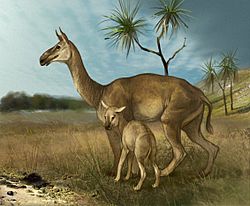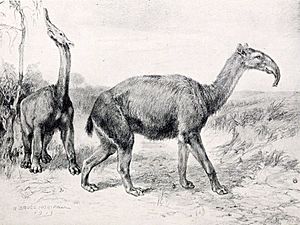Macrauchenia facts for kids
Quick facts for kids MacraucheniaTemporal range: Late Miocene to Late Pleistocene
|
|
|---|---|
 |
|
| Artistic drawing of Macrauchenia | |
| Conservation status | |
|
Fossil
|
|
| Scientific classification | |
| Kingdom: | |
| Phylum: | |
| Class: | |
| Order: |
†Litopterna
|
| Family: |
†Macraucheniidae
|
| Genus: |
†Macrauchenia
|
| Binomial name | |
| Macrauchenia patagonica Owen, 1838
|
|
Macrauchenia was an ancient hoofed mammal that lived a long time ago. It had a long neck and might have had a trunk, like an elephant. This animal walked on four legs and lived during the Pleistocene epoch. Scientists have found Macrauchenia fossils in Argentina, South America. It was a plant-eater, also known as an herbivore, and had special teeth for chewing plants.
What Did Macrauchenia Look Like?
Macrauchenia looked a bit like a camel, with strong legs and a long neck. Its head was quite small compared to its body. Its feet were more like those of a modern rhinoceros, with three hooves on each foot. It was a very large animal, about 3 meters (10 feet) long. It could weigh as much as 1042.8 kilograms (about 2,300 pounds). That's heavier than a small car!
One very interesting thing about Macrauchenia is where its nostrils were. Unlike most mammals, the openings for its nostrils were on top of its head. Some early scientists thought it might have used them like a snorkel, similar to a whale. But this idea was later proven wrong. Now, many scientists believe it had a trunk, perhaps to keep dust out of its nose. This trunk might have been like the nose of a modern Saiga antelope.
Scientists also learned something cool about Macrauchenia's movement. Its ankle joints and shin bones show that it could move very well. It could change direction quickly while running fast. This would have helped it escape from danger.
Like its relative Theosodon, Macrauchenia had a full set of 44 teeth.
How Did Macrauchenia Live?
Macrauchenia was a plant-eater, or herbivore. It probably ate leaves from trees or different kinds of grasses. Scientists studied its tooth enamel and found that it ate both tree leaves and grasses. They think it used its trunk to grab leaves and other food. It's also believed that Macrauchenia lived in groups, like modern wildebeest or antelope. Living in herds would have helped them protect each other from predators.
When Macrauchenia first appeared, it had to watch out for big South American predators. These included huge terror birds like Andalgalornis. There were also meat-eating mammals called sparassodontids, such as Thylacosmilus.
Later, during the late Pliocene and early Pleistocene, the Panama Isthmus formed. This land bridge connected North and South America. It allowed new predators from North America to come into South America. These new hunters included the cougar, the jaguar, the South American giant short-faced bear, the dire wolf, and the saber-toothed cat Smilodon. These new predators replaced many of the native South American hunters.
It's thought that Macrauchenia mainly escaped predators by running away. If running didn't work, it could kick them with its long, powerful legs. This is similar to how modern vicuña or camels defend themselves. Its ability to twist and turn quickly at high speeds would have made it hard for predators to catch.
Images for kids
See also
 In Spanish: Macrauquenias para niños
In Spanish: Macrauquenias para niños








